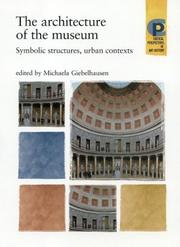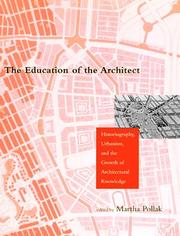| Listing 1 - 8 of 8 |
Sort by
|

ISBN: 0719056101 0719056098 Year: 2003 Volume: *1
Abstract | Keywords | Export | Availability | Bookmark
 Loading...
Loading...Choose an application
- Reference Manager
- EndNote
- RefWorks (Direct export to RefWorks)
Book
ISBN: 9782870099551 Year: 2007 Volume: *4 Publisher: Liège Mardaga [Pierre]
Abstract | Keywords | Export | Availability | Bookmark
 Loading...
Loading...Choose an application
- Reference Manager
- EndNote
- RefWorks (Direct export to RefWorks)
Architecture symbolism --- Symboliek in de architectuur --- Symbolism in architecture --- Symbolisme dans l'architecture --- Las Vegas (Nev.) --- Buildings, structures, etc. --- Architecture --- Nevada
Book
ISBN: 906271952X 9789062719525 Year: 2004
Abstract | Keywords | Export | Availability | Bookmark
 Loading...
Loading...Choose an application
- Reference Manager
- EndNote
- RefWorks (Direct export to RefWorks)
De natuur is gebaseerd op verhoudingen in de afmetingen van hoogte, breedte en diepte, die eveneens gehanteerd worden bij het bouwen van tempels en kerken om de deelnemer aan rituelen ontvankelijker te maken voor spirituele krachten.
Architecture and liturgy --- Architecture symbolism --- Geometry --- Géométrie --- Liturgical architecture --- Liturgie en architectuur --- Liturgie et architecture --- Liturgy and architecture --- Meetkunde --- Symboliek in de architectuur --- Symbolism in architecture --- Symbolisme dans l'architecture --- #gsdbA

ISBN: 0262161648 0262367998 9780262367998 9780262161640 Year: 1997 Publisher: Cambridge, Mass. ; London MIT Press
Abstract | Keywords | Export | Availability | Bookmark
 Loading...
Loading...Choose an application
- Reference Manager
- EndNote
- RefWorks (Direct export to RefWorks)
The authors of these eighteen essays have all been deeply influenced by the philosophy of architecture developed by Stanford Anderson, through his writings and through the teaching program of the Department of History, Theory and Criticism of Architecture, which he and Henry Millon founded at MIT over twenty years ago. This "school" of architectural thought views architecture as a world of inquiry and as a discipline anchored in the epistemological bases of contemporary philosophy, especially the philosophy of science. Whether historians or architects (and several have trained in both areas), the essayists all share the belief that contemporary concerns about architecture affect the way history is constructed. Because they view architecture as a body of knowledge evolving over time, they have resisted the wholesale espousal and rejection of modernism that has often polarized the examination and practice of architecture in the second half of this century.
Architecture symbolism --- Symboliek in de architectuur --- Symbolism in architecture --- Symbolisme dans l'architecture --- Architecture --- Architecture, Modern --- City planning --- Symbolism in architecture. --- Historiography. --- Philosophy. --- History --- urban development --- Aesthetics --- General ethics --- ethics [philosophy] --- aesthetics --- Environmental planning --- architectural theory --- Berlage, Hendrik Petrus --- Wright, Frank Lloyd --- Taut, Bruno --- Architecture [Modern ] --- 20th century --- Historiography --- Philosophy --- Architecture - Historiography. --- Architectural symbolism --- Signs and symbols in architecture --- ARCHITECTURE/Architectural History/General
Book
ISBN: 9782804700072 9782804705572 2804700070 2804705579 2804705579 Year: 2008 Volume: *1 Publisher: Wavre: Mardaga,
Abstract | Keywords | Export | Availability | Bookmark
 Loading...
Loading...Choose an application
- Reference Manager
- EndNote
- RefWorks (Direct export to RefWorks)
Publié par un couple de jeunes architectes et enseignants qui y sonnent la révolte, Learning from Las Vegas cristallise les débats dans le milieu architectural américain du début des années soixante-dix. Aux constructions imaginaires d'un monde meilleur, l'ouvrage oppose l'observation de la réalité, faisant de la ville existante - ici Las Vegas - un modèle à reproduire, imiter, ou parodier. Il rompt ainsi brutalement avec l'idéologie moderniste où la création architecturale ou urbanistique suppose une tabula rasa, une page blanche, ouvrant la voie à bien des écrits d'architectes qui, depuis, ont inversé le rapport entre théorie et réel. Derrière le questionnement de l'utopie, surgit une mise en cause de l'arrogance à laquelle se laissent aller parfois les architectes. Learning from Las Vegas, plaidoyer pour une pratique conventionnelle et une production « ordinaire », dénonce toujours avec la même force l'architecture « héroïque et originale » du nouvel « establishment ».
Architecture symbolism --- Symboliek in de architectuur --- Symbolism in architecture --- Symbolisme dans l'architecture --- Morphologie architecturale --- Théorie de l'architecture --- Symbolisme --- Venturi, Robert --- Las vegas --- Architecture --- Nevada --- Las Vegas (Nev.) --- City planning --- Urbanisme --- Symbolisme en architecture --- Buildings, structures, etc. --- Constructions --- Symbolisme en urbanisme --- 1945-.... --- Venturi, Robert, --- Symbolisme en architecture. --- Symbolisme en urbanisme. --- Venturi, Robert, 1925-2018 --- Symbole en architecture
Book

ISBN: 287143168X 9782871431688 Year: 2006 Publisher: Bruxelles: Archives d'architecture moderne,
Abstract | Keywords | Export | Availability | Bookmark
 Loading...
Loading...Choose an application
- Reference Manager
- EndNote
- RefWorks (Direct export to RefWorks)
Née dans les Iles Britanniques au début du XVIIIe siècle, la franc-maçonnerie moderne se donne rapidement des lieux de réunions discrets qui, à ce jour, n'ont été que peu étudiés dans le cadre de l'histoire de l'architecture. La construction d'un temple maçonnique, modeste ou spectaculaire, répond en réalité à un programme symbolique très codifié qui prend comme référence mythique le temple de Salomon à Jérusalem et s'élabore à partir d'un rituel complexe, puisant à de nombreux courants spirituels. Du temple égyptien ou assyrien à la tradition classique conçue comme un modèle idéal et universel, de la cathédrale médiévale au modernisme, la loge offre un éventail de références exceptionnellement large. Chaque pays, chaque obédience, chacun des courants maçonniques, contribuent à créer un panorama architectural d'une fascinante richesse. http://www.eyrolles.com/Loisirs/Livre/architectures-maconniques-9782871431688(14/09/10)
Social organizations --- Architecture --- France --- Belgium --- United States --- Great Britain --- Architecture symbolism --- Symboliek in de architectuur --- Symbolism in architecture --- Symbolisme dans l'architecture --- Freemasonry and the arts --- Freemasonry --- Franc-maçonnerie et arts --- Franc-maçonnerie --- Lodges --- History --- Loges --- Histoire --- Symbolism in architecture. --- Architecture. --- Symbolism. --- Espace sacré --- Histoire de l'architecture --- Ordre maconnique --- Patrimoine architectural --- Symbole en architecture --- Symbolique --- Franc-maconnerie --- Temple --- Utopie architecturale --- Symbolism --- Gossé, Marcel --- Freemasons --- Buildings --- Angleterre --- Belgique --- Bruxelles --- Gand --- 72.03 --- 061.2 --- Groot-Brittannië --- Frankrijk --- België --- Verenigde Staten --- Architectuur ; vrijmetselarij --- Tempels ; loge --- 726.1 --- Architectuur (geschiedenis) --- Architectuurgeschiedenis --- Vrijmetselarij --- Religieuze architectuur ; tempels, heiligdommen, pagoden --- Buildings. --- Franc-maçonnerie et arts --- Franc-maçonnerie --- Architectural symbolism --- Signs and symbols in architecture --- A.F. & A.M. --- A.L.A.M. --- AF and AM --- ALAM (Secret order) --- Ancient Free and Accepted Masons --- Antichi liberi accettati muratori --- F. & A.M. --- F. and A.M. --- Farāmāsūnhā --- Franc-Maçonnerie (Secret order) --- Francmasoneria --- Francs-Maçons --- Free & Accepted Masons --- Free and Accepted Masons --- Free Masonry --- Freemasonari --- Freemasonary --- Freimaurer --- Freimaurer-Gesellschaft --- Frimurere --- Furīmēson --- Maçonaria --- Maçons --- Masoneriá --- Masonia --- Masons (Secret order) --- Masonstvo --- Masony --- Massoneria --- Māsūnīyah --- Most Ancient and Honourable Fraternity of Free and Accepted Masons --- Ordena Volʹnykh kamenshchikov --- Szabadkőművesség --- Tektonismos --- Volʹnye kamenshchiki --- Grande-bretagne --- Freemasonry - Symbolism --- Mopses (Secret society) --- United States of America --- architecture [discipline] --- Freemasonry [belief system]
Book
ISBN: 9782503548791 2503548792 Year: 2013 Volume: 14 140 4 Publisher: Turnhout: Brepols,
Abstract | Keywords | Export | Availability | Bookmark
 Loading...
Loading...Choose an application
- Reference Manager
- EndNote
- RefWorks (Direct export to RefWorks)
"William Durand (c. 1230-Nov. 1, 1296), Bishop of Mende, France, was unquestionably the most renowned liturgical scholar of the later Middle Ages. His encyclopedic allegorical exposition of the rites and worship services of the Latin Church, the Rationale divinorum officiorum, or "Rationale for the divine offices, " is the best known medieval work in its genre. Divided into eight books of varying length, the Rationale is exhaustive in its treatment of a wide variety of subjects: the church building and liturgical art; the ministers of the church and their functions; liturgical vestments; the Mass and the Divine Office; the Church's calendar and its feast days. Modern scholarship has clearly shown that Durand's Rationale superseded all previous liturgical commentaries within only a few years of its publication (c. 1292-1296). By the end of the fifteenth century, it had become one of the most widely disseminated treatises of its kind in western Europe."--Publisher description.
Architecture religieuse --- Architecture symbolism --- Art [Christian ] --- Art [Eclesiastical ] --- Art chrétien --- Art ecclésiastique --- Art et symbolisme chrétiens --- Art religieux chrétien --- Art sacré --- Arts in the Church --- Christelijke iconografie --- Christelijke kunst en symboliek --- Christelijke symboliek --- Christian art and symbolism --- Christian symbolism --- Ecclesiastical art --- Godsdienstige kunst [Christelijke ] --- Iconografie [Christelijke ] --- Iconographie chrétienne --- Kerkelijke kunst --- Kunst [Christelijke ] --- Kunst [Godsdienstige ] [Christelijke ] --- Kunst [Kerkelijke ] --- Kunst [Sacrale ] --- Religieuze architectuur --- Religious architecture --- Religious art [Christian ] --- Sacrale kunst --- Sacred art --- Spiritual architecture --- Symboliek [Christelijke ] --- Symboliek in de architectuur --- Symbolism in architecture --- Symbolisme chrétien --- Symbolisme dans l'architecture --- Mass --- Messe --- Early works to 1800. --- Ouvrages avant 1800 --- Durand, Guillaume, --- Catholic Church --- Liturgy --- 2 DURANDUS, GUILELMUS --- 2 DURANDUS, GUILELMUS Godsdienst. Theologie--DURANDUS, GUILELMUS --- Godsdienst. Theologie--DURANDUS, GUILELMUS --- Church of Rome --- Roman Catholic Church --- Katholische Kirche --- Katolyt︠s︡ʹka t︠s︡erkva --- Römisch-Katholische Kirche --- Römische Kirche --- Ecclesia Catholica --- Eglise catholique --- Eglise catholique-romaine --- Katolicheskai︠a︡ t︠s︡erkovʹ --- Chiesa cattolica --- Iglesia Católica --- Kościół Katolicki --- Katolicki Kościół --- Kościół Rzymskokatolicki --- Nihon Katorikku Kyōkai --- Katholikē Ekklēsia --- Gereja Katolik --- Kenesiyah ha-Ḳatolit --- Kanisa Katoliki --- כנסיה הקתולית --- כנסייה הקתולית --- 가톨릭교 --- 천주교
Book
ISBN: 3786111642 Year: 1994 Publisher: Berlin Gebr.Mann Verlag
Abstract | Keywords | Export | Availability | Bookmark
 Loading...
Loading...Choose an application
- Reference Manager
- EndNote
- RefWorks (Direct export to RefWorks)
72.033 --- 72.033.5 --- 72.033.4 --- Middeleeuwen (architectuur) --- Middeleeuwse architectuur --- Gotische architectuur --- Gotiek (architectuur) --- Romaanse architectuur --- Architecture [Medieval ] --- Architecture symbolism --- Architectuur [Middeleeuwse ] --- Bouwkunst [Middeleeuwse ] --- Medieval architecture --- Middeleeuwse bouwkunst --- Symboliek in de architectuur --- Symbolisme dans l'architecture --- -Decoration and ornament, Medieval --- Günter Bandmann --- 72.033.4/5 --- Architecture, Medieval --- Christian art and symbolism --- Decoration and ornament, Architectural --- Decoration and ornament, Medieval --- Symbolism in architecture --- 72.01 --- architectuur --- architectuurgeschiedenis --- architectuurtheorie --- Europa --- gotiek --- Middeleeuwen --- romaanse kunst --- 72.01 Architectuurtheorie. Bouwprincipes. Esthetica van de bouwkunst. Filosofie van de bouwkunst --- Architectuurtheorie. Bouwprincipes. Esthetica van de bouwkunst. Filosofie van de bouwkunst --- Middle Ages --- 72.033 Bouwstijlen van de Middeleeuwen (ca 476-1492) --- Bouwstijlen van de Middeleeuwen (ca 476-1492) --- Architectural symbolism --- Signs and symbols in architecture --- Architecture --- Architectural decoration and ornament --- Stonework, Decorative --- Architectural design --- Exterior walls --- Decoration and ornament --- Art [Medieval ] --- Themes, motives --- 72.01 Theory and philosophy of architecture. Principles of design, proportion, optical effect --- Theory and philosophy of architecture. Principles of design, proportion, optical effect
| Listing 1 - 8 of 8 |
Sort by
|

 Search
Search Feedback
Feedback About UniCat
About UniCat  Help
Help News
News